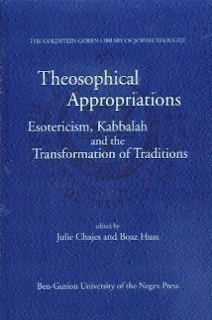Theosophical
Appropriations: Esotericism, Kabbalah, and the Transformation of Traditions, edited by Julie
Chajes and Boaz Huss
The Goldstein-Goren Library of
Jewish Thought Publication no. 21 - Ben-Gurion
University of the Negev Press / The
Bialik Institute, Jerusalem
Appreciation of the historical
importance of the Theosophical Society (henceforth, TS) and related movements
is growing, and rightly so, yet the extent of theosophical influences can still
be surprising, even to scholars in the field. The chapters of this volume
contribute to our increasing recognition of the global impact of the TS and its
ideas and illustrate lesser-known instances of theosophical appropriation
aroundthe world.
https://www.academia.edu/28144662/Theosophical_Appropriations_Esotericism_Kabbalah_and_the_Transformation_of_Traditions_edited_by_Julie_Chajes_and_Boaz_HussIn the opening paper, Julie Chajes discusses two of Blavatsky’s early works that refer to Kabbalah: “A Few Questions to Hiraf” (1875) and Isis Unveiled (1877). The chapter elucidates Blavatsky’s doctrines of Kabbalah in those texts, each of which have distinct emphases. (Intro 11)
https://www.academia.edu/26543875/Construction_Through_Appropriation_Kabbalah_in_Blavatskys_Early_Works
https://www.youtube.com/watch?v=fQnvizvv5S0
Isaac Lubelsky - Friedrich Max Müller vs. Madame Blavatsky: A Chronicle of a (Very) Strange Relationship p. 73
In the following chapter, Isaac Lubelsky charts the relationship between Madame Blavatsky and the renowned German-born Oxford Orientalist, Friedrich Max Müller (1823-1900). Blavatsky’s references to Müller are often mentioned in passing in accounts of her sources, but this is the first detailed exploration of this topic, looking at the relationship from both sides. (Intro 13)
https://docs.wixstatic.com/ugd/5d1f91_77de77481c854b4f9f10a12c464ef72d.pdf
https://www.youtube.com/watch?v=uJRlXz6lBr0
John Patrick Deveney - The Two Theosophical Societies:Prolonged Life, Conditional Immortality,and the Individualized Immortal Monad93
These demonstrate, Deveney
argues, that the Society as established in 1875 was devoted to practical occult
work, and specifically to the development of the ability to project the astral
double. This ability was considered an indication of the fusion of the
student’s “individuality” with their “divine spirit” to create an
“individualized”entity capable of surviving death.
https://www.youtube.com/watch?v=6BKVCI882gQ
Boaz
Huss - “Qabbalah, the Theos-Sophia of
the Jews:” Jewish Theosophists and their
Perceptions of Kabbalah
Huss surveys the numerous books
and articles of Jewish theosophists, demonstrating that overall, Jewish
theosophists had greater access to primary texts of Kabbalah than did
non-Jewish theosophists, and some even had enough knowledge of Hebrew and
Aramaic to prepare their own translations. Nevertheless, their knowledge of
primary sources was limited and even those who did have some language skills
largely based themselves on secondary literature, including Western esoteric,
theosophical, and academic texts.
https://www.academia.edu/28239752/Qabbalah_The_Theos-Sophia_of_the_Jewshttps://www.youtube.com/watch?v=--dl6zYMuEA
Shimon Lev - Gandhi and his Jewish Theosophist Supporters in
Lev discusses the political
activism of these Jewish theosophists, their involvement in the satyågraha
struggle and their friendships with Gandhi, which were often very close. Lev
highlights the tension between South-African Jewish identification with the
ruling white elite and Jewish critique of that establishment, speculating about
a self-perception shared between Jews and Indians as “Oriental” immigrants in South Africa . He notes the appeal of a Theosophical
Society that enabled the exploration of unorthodox ideas but which, at the same
time, did not require the abandonment of Jewish identity.
https://www.youtube.com/watch?v=K7cYTbb61OE
No comments:
Post a Comment